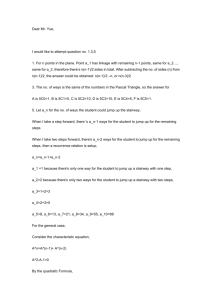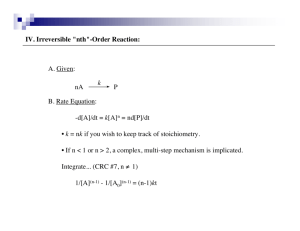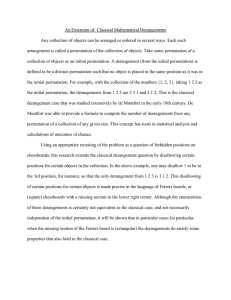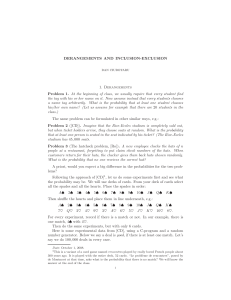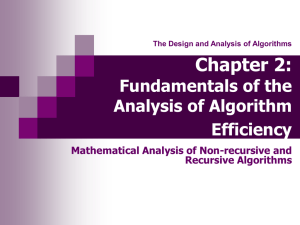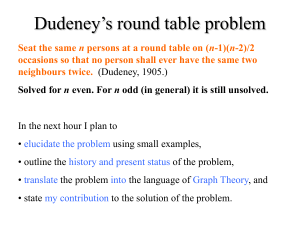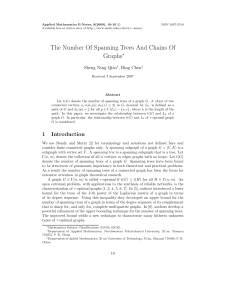Lecture18InclExcl
advertisement
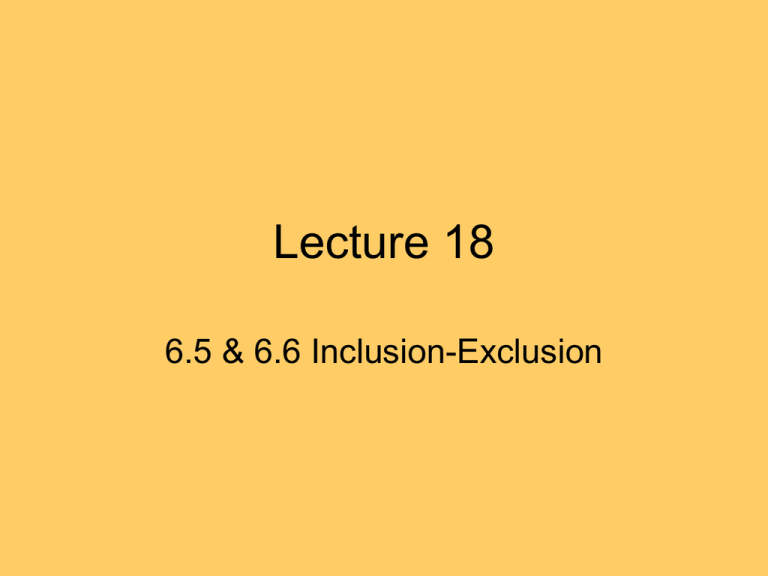
Lecture 18 6.5 & 6.6 Inclusion-Exclusion 6.5 Inclusion-Exclusion U A A A B B | A B || A | | B | | A B | It’s simply a matter of not over-counting the blue area in the intersection. Now three Sets area = 4-3=1 U C area = 2-1=1 B C A C A B C area = 1 A A B B Image a blue circle has area 4. The intersections between 2 circles have area 2 and the intersection between three circles 1. What is the total area covered? | A B C || A | | B | | C | | A B | | B C | | C A=4+4+4 – 2 -2 -2 + 1 = 12 – 6 + 1 = 7. A| | A B C | General Case n | A1 ... An | | Ai | A2 i 1 Aj | | Ai pairs ( ij ) (1)n 1 | Ai Aj | Ai Aj Ak | ... triples ( ijk ) Ak ... An | Proof: We show that each element is counted exactly once. Assume element ‘a’ is in r sets out of the n sets A1,...,An. -The first term counts ‘a’ r-times=C(r,1). -The second term counts ‘a’ -C(r,2) times (there are C(r,2) pairs in a set of r elements). -The k’th term counts ‘a’ -C(r,k) times (there are C(r,k) k-subsets in a set of r elements). -... - If k=r then there are precisely (-1)^(r+1) C(r,r) terms. - For k>r ‘a’ is not in the intersection: it is counted 0 times. Total: C(r,1)-C(r,2)+...+(-1)^(r+1)C(r,r) r (1) C (r , k ) 0 Now use: k k 0 r 1 (1) k 1 C ( r , k ) k 1 to show that each element is counted exactly once. Applications of Incl.-Excl. We can use inclusion/exclusion to count the number of members of a set that do not have a bunch of properties: P1,P2,...,Pn. Call N(Pi,Pj,Pk,...) the number of elements of a set that do have properties Pi, Pj, Pk,.... and N the total number of elements in the set. By inclusion/exclusion we then have: Theorem: Let Ai be the subset of elements of a set A that has property Pi. The number of elements in a set A that do not have properties P1,...Pn is given then by: | A | | A1 A2 A3 ... An | n n i 1 i , j 1 i j N N ( Pi ) N ( Pi , Pj ) with N ( Pi , Pj , Pk ,...) | Ai n N ( Pi , Pj , Pk ) ... (1) n N ( P1 , P2 ,..., Pn ) Aj Ak i , j , k 1 i j k ... | A Picture U C B C A C A B C A A B B |U | | A B C | Examples Compute the number of solutions to x1+x2+x3=11 where x1,x2,x3 non-negative integers and x1 <=3, x2<=4, x4<=6. P1: x1 > 3 P2: x2 > 4 P3: x3 > 6 The solution must have non of the properties P1,P2,P3. The solution of a problem x1+x2+x3=11 with constraints x1 > 3 is solved as follows: 7 more balls 4 balls in basket x1 already. x1 x2 x3 Total number of ways: C(7+3-1,7)=36 Therefore: N-N(P1)-N(P2)-N(P3)+N(P1,P2)+N(P2,P3)+N(P1,P3)-N(P1,P2,P3) C(11+3-1,11) – C(7+3-1,7) – C(6+3-1,6) ... – 0. Connection with De Morgan’s law n Ai i 1 Ai i 1 n Ai | U | i 1 n n n i 1 n Ai | U | | Ai | | Ai i 1 A j | ... (1) n | A1 ... An | i, j i j n Ai i 1 So we have 2 ways to solve the last example: x1+x2+x3 = 11 such that non of the following properties hold: P1: x1 > 3 P2: x2 > 4 Sometimes this is easier to compute. P3: x3 > 6 or x1+x2+x3=11 such all of the following properties hold: Q1=NOT P1: 0<x1<=3 Q2=NOT P2: 0<x2<=4 Q3=NOT P3: 0<x3<=6 Number of Onto-Functions Onto or surjective functions: A function f from A to B is onto if for every element b in B there is an element a in A with f(a)=b. If we have m elements in A and n in B, how many onto functions are there? x y f We want all yi in the range of the function f. Call Pi the property that yi is not in the range of the the function f. Then we are looking for the number of functions that has none of the properties P1,...,Pn A B There is no element without incoming arrows Number of Onto-Functions N-N(P1)-N(P2) ... + N(P1,P2) -...+(-1)^n N(P1,...,Pn). N: number of function from A B: n^m N(Pi): number of functions that do not have y1 in its range: (n-1)^m. There are n=C(n,1) such terms. N(Pi,Pj): (n-2)^m with C(n,2) terms. x y f Total: n^m – C(n,1)(n-1)^m + C(n,2)(n-2)^m – ...+(-1)^(n-1)C(n,n-1)1^m. A B There is no element without incoming arrows Derangements A derangement: is a permutation that leaves non of the elements in its place. Example: (3,2,1) is not a derangement, but (2,3,1) is one. Then: how many derangements are there of a set of n elements. This is the answer to the Hatcheck problem: If n people check in their hats and the employee randomly returns hats back to people: what is the probability no-one gets their own hat back: P = number of derangements of n / total number of permutations = Dn / n! Derangements A permutation is a one-to-one correspondence of a set A with n elements to a B set n elements. There are n! such functions. permutation Call Pi the property that xi is mapped to yi at the same “position”. Then the total number of derangements is the number of permutation that do not have properties P1,P2,P3,...Pn. Example: (1,2,3) A1: (1,2,3) & (1,3,2) A2: (1,2,3) & (3,2,1) A3: (1,2,3) & (2,1,3) A12: (1,2,3) A13: (1,2,3) A23: (1,2,3) A123: (1,2,3) A total = 6-3x2+3x1-1=2 namely: (3,1,2) and (2,3,1) B Derangements More generally we have: N(Pi) = (n-1)! and there are C(1,n) such terms N(Pi,Pj) = (n-2)! and there are C(n,2) such terms. Total: Dn = n! – C(n,1)(n-1)! + C(n,2)(n-2)! - ...+ (-1)^n C(n,n) (n-n)! = n! – [n!/1!(n-1)!] (n-1)! + [n!/2!(n-2)!](n-2)! ... = n!(1-1/1! + 1/2! -1/3!+...+(-1)^n 1/n!) P(hatcheck) = 1-1/1!+1/2!-...(-1)^n1/n! = 0.368 if n is large. so even if 1M people check in their hat there is a probability of 0.368 that no-one gets there hat returned correctly. Excercises On White Board. THE END... Next time we will do a review of the material you need to know for your final exam. This will be useful if you want to know what kind of questions to expect and on what topics. I will also ask you to fill out evaluation forms.


